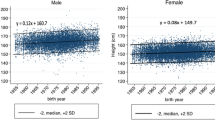Abstract
Objectives
The purpose of this study is to define and clarify the causes of differences in physique between urban students and rural students in China.
Methods
Subjects are 2,524 students (male, 838; female, 1686) who entered K University in Shanghai in September, 2001. The data used in this study is based upon K university’s Yearly Health Check Record and Students’ Family Condition Record. Correlation analysis, analysis of variance (ANOVA) and analysis of covariance (ANCOVA) were applied to analyze the relationships between physique and gross family income, family income per capita, latitude, air temperature, precipitation or altitude.
Results
Urban students’ height and weight are significantly greater than rural students’ in both males and females. Both male students and female students are significantly taller and heavier in accordance with per capita increases in students’ family income. The height and weight of male and female students whose parents are peasant farmers are least. With regard to the relationship between physique and urban-rural factors, the F value decreases clearly when family income per capita is taken as a covariate, while the F values slightly decrease also when factors of latitude etc. are taken as covariates. The main cause of differing family income is occupational difference between urban areas and rural ones.
Conclusion
Students born in urban areas are taller and heavier than those born in rural areas. The main cause of these differences is family income per capita. The main cause of variations in family income is the income difference in occupations.
Similar content being viewed by others
References
Ye W. Macro-regulation of peasantry’s income distribution. BUAA J. 2001; 4: 46–49. (Article in Chinese)
Jiang C, Yu D, Hou M. Analysis and study of Chinese adults’ physical fitness in 1997. Sports Science. 1999; 4: 85–89. (Article in Chinese)
Jiang W, Xu H, Zhou J. Impact of Jiangsu regional economic development on Jiangsu residents’ physical fitness. Sports and Science. 2004; 2: 47–48. (Article in Chinese)
Ren J, Li R. Analysis about the difference of the university students’ physique between urban area and rural area in China. Sports Science. 1998; 6: 22–24. (Article in Chinese)
The Institute of Infancy in Beijing. A survey on the physical growth of children under 7 years in the urban and suburban rural areas of nine cities in China in 1995. Natl Med J China. 1998; 78: 187–191. (Article in Chinese)
Ji C. The geographic distribution characteristics of highstature youth in China. Sports Science. 2000; 1: 89–92. (Article in Chinese)
Shen T, Habicht JP, Chang Y. Effect of economic reforms on child growth in urban and rural areas of China. N Engl J Med. 1996; 335: 400–406.
Shun B, Jiang K. A study on the physique of adults in Jingsu province, China. Sports Science. 1999; 5: 88–91. (Article in Chinese)
Wang Y. Investigation and study of physique characteristics of improverished college students. Wuhan Institute of Physical Education J. 2004; 3: 62–65. (Article in Chinese)
Tang X, Wang Z, Wang D. District distribution of stature in Chinese youth. Acta Anthropologica Sinica. 1994; 2: 143–148. (Article in Chinese)
Yu D. The conception of physique with the health condition of Chinese university students. Shan Dong Institute of Physical Education J. 1994; 2: 7–14. (Article in Chinese)
Harris NS, Crawford PB, Yangzom Y, Pinzo L, Gyaltsen P, Hudes M. Nutritional and health status of Tibetan children living at high altitudes. N Engl J Med. 2001; 344: 341–347.
Ohsawa S, Ji C. Ecological correlations and anthropometric variations in Chinese youths. Jpn J School Health. 1995; 37: 318–328.
Zhang L. Study of relationships between people’s life standard and undergraduates’ physique since reform and opening-up to outside world in China for 20 years. Beijing University of Physical Education J. 2002; 5: 600–602. (Article in Chinese)
Xiu Y. Analysis and research on sports consumption and fitness of adults in Guangdong province. Guangzhou Physical Education Institute J. 1999; 1: 17–22. (Article in Chinese)
Chunming C. Fat intake and nutritional status of children in China. Am J Clin Nutr. 2000; 72 (suppl): 1368S-1372S.
Qian J. Analysis on university students’ physique for ten years in Jiangsu province. Sports and Science. 1996; 3: 65–67. (Article in Chinese)
Schmitt LH, Harrison GA. Patterns in within-population variability of stature and weight. Ann Hum Biol. 1988; 15: 353–364.
Takahashi E. Growth and environmental factors in Japan. Hum Biol. 1966; 38: 112–130.
Ashizawa K, Kumakura C, Kusumoto A. Growth of Philippine children in reference to socioeconomic environment. Anthropol Sci. 1998; 106: 77–94.
Bogin BA, MacVean RB. Growth in height and weight of urban Guatemalan primary school children of low and high socioeconomic class. Hum Biol. 1978; 50: 477–487.
Ren Q, Delong GR. Effect of environment supplementation of iodine on infant mortality and growth in children in Xinjiang, China. Chin J Epidemiol. 2002; 3: 198–202. (Article in Chinese)
Shan F, Liu H. The reduction of difference in income distribution and economic growth. Contemporary Finance & Accounting. 2001; 6: 8–11. (Article in Chinese)
Chen Z. Dynamic Analyses on the Study of Children’s Physical Morphology among 50 Years in Guangzhou, Guangdong province. Guangzhou: Guangdong Gao Deng Jiao Yu Publishing House; 2003. (Book in Chinese)
Shanghai Statistical Bureau. Shanghai Statistical Yearbook. Beijing: China Statistical Publishing House: 2002. p. 4. (Book in Chinese)
Li W. Effects of monopoly on incomes of Chinese vocational groups and their countermearues. Nanjing Institute of Polities J. 2001; 3: 54–57. (Article in Chinese)
Chui J. A study on the problem of income distribution with urban inhabitants. Population & Eco. 1998; 2: 54–56. (Article in Chinese)
Lee SK, Sobal J. Socio-economic, dietary, activity, nutrition and body weight transitions in South Korea. Public Health Nutr. 2003; 6: 665–674.
Marshall WA. Geographic and ethnic variations in human growth. Br Med Bull. 1981; 37: 273–279.
Author information
Authors and Affiliations
Corresponding author
Rights and permissions
About this article
Cite this article
Yin, X.J., Huang, C.Q., Chen, H.M. et al. Associations of physique with the socioeconomic factors of family and regional origin in Chinese university students. Environ Health Prev Med 10, 190–200 (2005). https://doi.org/10.1007/BF02897710
Received:
Accepted:
Issue Date:
DOI: https://doi.org/10.1007/BF02897710




